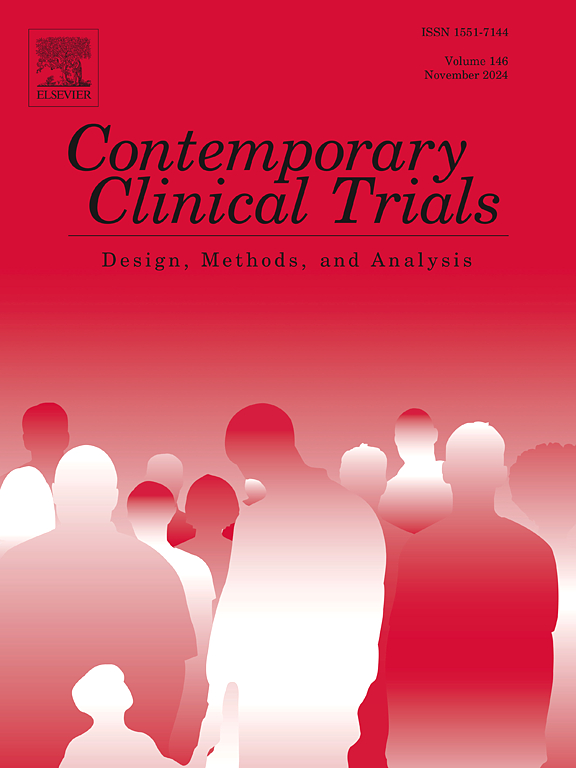Predictors of non-arrival at initial study screening visits among Black adults: Data from the GoFresh trials
IF 1.9
3区 医学
Q3 MEDICINE, RESEARCH & EXPERIMENTAL
引用次数: 0
Abstract
Background
Trial recruitment is a major determinant of study success, and participants' non-arrival at study visits represents a significant barrier to study completion. Little is known about the participant and study process characteristics associated with visit non-arrival.
Objective
To investigate factors associated with non-arrival at initial in-person screening visits in two ongoing randomized controlled trials.
Methods
The Groceries for Black Residents of Boston to Stop Hypertension trials (GoFresh and GoFreshRx) studied whether home-delivered, DASH-patterned groceries can reduce blood pressure among Black adults living in urban food priority areas. In this analysis, we examined sociodemographic and study-related factors associated with participant non-arrival at their initial study visit (defined as rescheduling or not showing up at all). Associations were determined using logistic regression with adjustment for age, estimated gender, and hypertension treatment status.
Results
Among 2224 participants (mean age = 44.0 years, 72.5 % women), the non-arrival rate at screening visit 1 was 29.5 %. Older participants were more likely to arrive, while those with larger families and a longer duration between initial contact and visit were less likely to arrive. Participants’ method of contacting the study, visit time, and season of visit were not associated with visit non-arrival.
Conclusion
In this large trial recruitment drive, older age, larger family size, and a longer time between initial contact and scheduled visit were associated with non-arrival at initial study visits. These factors represent potential targets for future interventions that either accommodate patient factors or intervene upon study process barriers to achieve timely recruitment goals.
在黑人成人中未到达最初研究筛选访问的预测因素:来自GoFresh试验的数据。
背景:试验招募是研究成功的主要决定因素,参与者未到达研究访问是研究完成的一个重大障碍。很少知道参与者和研究过程特征与访问未到达相关。目的:在两项正在进行的随机对照试验中,探讨未到达首次亲自筛查的相关因素。方法:波士顿黑人居民停止高血压的食品杂货试验(GoFresh和GoFreshRx)研究了家庭送货,dash模式的食品杂货是否可以降低生活在城市食品优先区域的黑人成年人的血压。在本分析中,我们检查了与参与者未到达初始研究访问(定义为重新安排或根本未出现)相关的社会人口统计学和研究相关因素。通过调整年龄、估计性别和高血压治疗状况的logistic回归来确定相关性。结果:在2224名参与者中(平均年龄 = 44.0 岁,72.5 %为女性),筛查访问1时未到达率为29.5 %。年龄较大的参与者更有可能到达,而那些家庭规模较大,初次接触和访问之间的时间较长的人则不太可能到达。参与者联系研究的方法、访问时间和访问季节与访问未到达无关。结论:在这项大规模的试验招募活动中,年龄较大、家庭规模较大、初次接触和预定访问之间的时间较长与初次研究访问未到达有关。这些因素代表了未来干预措施的潜在目标,这些干预措施要么适应患者因素,要么干预研究过程中的障碍,以实现及时的招募目标。
本文章由计算机程序翻译,如有差异,请以英文原文为准。
求助全文
约1分钟内获得全文
求助全文
来源期刊
CiteScore
3.70
自引率
4.50%
发文量
281
审稿时长
44 days
期刊介绍:
Contemporary Clinical Trials is an international peer reviewed journal that publishes manuscripts pertaining to all aspects of clinical trials, including, but not limited to, design, conduct, analysis, regulation and ethics. Manuscripts submitted should appeal to a readership drawn from disciplines including medicine, biostatistics, epidemiology, computer science, management science, behavioural science, pharmaceutical science, and bioethics. Full-length papers and short communications not exceeding 1,500 words, as well as systemic reviews of clinical trials and methodologies will be published. Perspectives/commentaries on current issues and the impact of clinical trials on the practice of medicine and health policy are also welcome.

 求助内容:
求助内容: 应助结果提醒方式:
应助结果提醒方式:


